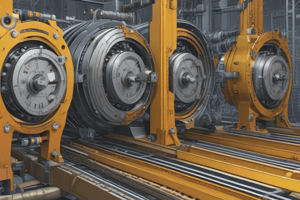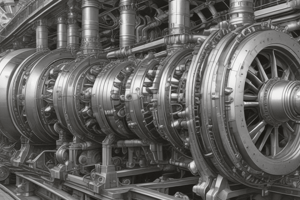Podcast
Questions and Answers
What is the principle of pneumatic methods in force measurement?
What is the principle of pneumatic methods in force measurement?
- Converting force into electrical signals
- Generating an electrical charge in response to mechanical stress
- Using gas pressure to measure force (correct)
- Measuring force through the strain of an elastic element
Which of the following is NOT a type of electrical method for force measurement?
Which of the following is NOT a type of electrical method for force measurement?
- Strain Gauge Load Cells
- Inductive Load Cells
- Piezoelectric Load Cells
- Hydraulic Load Cells (correct)
What is the application of capacitive load cells?
What is the application of capacitive load cells?
- Industrial automation and machinery control systems
- Weighing scales and structural testing
- Dynamic force measurement and vibration analysis
- Precision force measurement in laboratory instruments and robotic applications (correct)
What is the advantage of electrical methods in force measurement?
What is the advantage of electrical methods in force measurement?
What is the principle of Prony Brake in torque measurement?
What is the principle of Prony Brake in torque measurement?
What is the application of absorption dynamometers?
What is the application of absorption dynamometers?
Which of the following is a common application of pneumatic methods?
Which of the following is a common application of pneumatic methods?
What is the advantage of hydraulic methods in force measurement?
What is the advantage of hydraulic methods in force measurement?
What is the principle behind Hydraulic Torque Sensors?
What is the principle behind Hydraulic Torque Sensors?
Which type of torque sensor is commonly used in automotive powertrains and industrial automation?
Which type of torque sensor is commonly used in automotive powertrains and industrial automation?
What is the principle behind Mechanical Dynamometers?
What is the principle behind Mechanical Dynamometers?
Which type of dynamometer is used in heavy-duty engine testing and industrial applications?
Which type of dynamometer is used in heavy-duty engine testing and industrial applications?
What is the principle behind Optical Torque Sensors?
What is the principle behind Optical Torque Sensors?
Which type of torque sensor is commonly used in industrial machinery and automotive testing?
Which type of torque sensor is commonly used in industrial machinery and automotive testing?
What is the principle behind Electrical Dynamometers?
What is the principle behind Electrical Dynamometers?
What is the principle behind Power Analyzers?
What is the principle behind Power Analyzers?
What is the principle behind mechanical methods of force measurement?
What is the principle behind mechanical methods of force measurement?
Which of the following is NOT a type of mechanical method used in force measurement?
Which of the following is NOT a type of mechanical method used in force measurement?
What is the application of Proving Rings in force measurement?
What is the application of Proving Rings in force measurement?
What is the principle behind hydraulic methods of force measurement?
What is the principle behind hydraulic methods of force measurement?
What is the component that converts force into fluid pressure in hydraulic methods?
What is the component that converts force into fluid pressure in hydraulic methods?
What is the application of hydraulic methods in force measurement?
What is the application of hydraulic methods in force measurement?
Which of the following is a common application of Spring Scales?
Which of the following is a common application of Spring Scales?
What is the principle behind Lever Systems in force measurement?
What is the principle behind Lever Systems in force measurement?
What is the primary advantage of electrical methods in mechanical engineering applications?
What is the primary advantage of electrical methods in mechanical engineering applications?
In which type of application is a Pitot-Static tube commonly used?
In which type of application is a Pitot-Static tube commonly used?
What is the principle of operation of a Rotameter?
What is the principle of operation of a Rotameter?
What is the primary component of a Turbine Meter?
What is the primary component of a Turbine Meter?
What is the primary purpose of the electromagnetic coils in an electromagnetic flow meter?
What is the primary purpose of the electromagnetic coils in an electromagnetic flow meter?
Which flow measurement method is suitable for measuring flow rates in HVAC systems?
Which flow measurement method is suitable for measuring flow rates in HVAC systems?
Which factor does not affect the selection of a flow measurement method?
Which factor does not affect the selection of a flow measurement method?
What is the principle of operation of an Orifice Meter?
What is the principle of operation of an Orifice Meter?
What is the relationship between the induced voltage and flow velocity in an electromagnetic flow meter?
What is the relationship between the induced voltage and flow velocity in an electromagnetic flow meter?
Which flow measurement method is commonly used in water and wastewater treatment?
Which flow measurement method is commonly used in water and wastewater treatment?
Which type of flow meter is suitable for measuring flow rates in abrasive fluids?
Which type of flow meter is suitable for measuring flow rates in abrasive fluids?
What is the primary advantage of using a Turbine Meter in industrial flow measurement?
What is the primary advantage of using a Turbine Meter in industrial flow measurement?
What is the purpose of the flow transmitter in an electromagnetic flow meter?
What is the purpose of the flow transmitter in an electromagnetic flow meter?
Which of the following is not an application of electromagnetic flow meters?
Which of the following is not an application of electromagnetic flow meters?
What is the principle of operation of an electromagnetic flow meter?
What is the principle of operation of an electromagnetic flow meter?
Which type of flow meter is suitable for measuring flow rates in a wide range of fluid types?
Which type of flow meter is suitable for measuring flow rates in a wide range of fluid types?
Study Notes
Force Measurement
- Force measurement is crucial in various mechanical engineering applications, including material testing, structural analysis, and machinery control.
- Different methods are employed to measure force, including:
- Mechanical methods: use deformation of materials under load to measure force.
- Hydraulic methods: use fluid pressure to measure force, based on Pascal's Law.
- Pneumatic methods: use gas pressure to measure force.
- Electrical methods: use electrical signals to measure force, often involving transducers that convert mechanical deformation into electrical output.
Mechanical Methods
- Spring Scales: use deformation of a spring to measure force, applications include common weighing scales and tension/compression tests.
- Lever Systems: use levers to magnify the applied force, which can then be measured using calibrated weights or other force transducers, applications include mechanical balances and force amplifiers.
- Proving Rings: measure force by the deformation of a circular ring, applications include calibration of testing machines and high-precision force measurement.
Hydraulic Methods
- Principle: use fluid pressure to measure force, based on Pascal's Law.
- Components: piston-cylinder arrangement, pressure gauge.
- Operation: an applied force compresses a fluid in a piston-cylinder setup, the fluid pressure generated is measured by a pressure gauge, which is proportional to the applied force.
- Applications: hydraulic presses, force calibration systems, heavy machinery.
Pneumatic Methods
- Principle: use gas pressure to measure force.
- Components: piston-cylinder arrangement, pressure gauge.
- Operation: an applied force compresses a gas in a piston-cylinder setup, the gas pressure is measured using a pressure gauge, which relates to the applied force.
- Applications: pneumatic actuators, force measurement in low-force applications, industrial automation.
Electrical Methods
- Principle: use electrical signals to measure force, often involving transducers that convert mechanical deformation into electrical output.
- Types:
- Strain Gauge Load Cells: measure force through the strain (deformation) of an elastic element, detected by strain gauges.
- Piezoelectric Load Cells: use piezoelectric materials that generate an electrical charge in response to mechanical stress.
- Capacitive Load Cells: measure force by changes in capacitance due to the displacement of conductive plates.
- Inductive Load Cells: use inductance changes in a coil due to the displacement caused by force.
Torque and Power Measurements
- Torque and power measurements are essential for assessing the performance and efficiency of engines, motors, and other mechanical systems.
- Different methods are used to measure torque and power accurately, including:
- Mechanical methods: use mechanical components to measure torque and power.
- Hydraulic methods: use hydraulic systems to measure torque and power.
- Electrical methods: use electrical signals to measure torque and power.
Mechanical Methods
- Prony Brake: measures torque by applying a known frictional force to a rotating shaft and measuring the resulting force and lever arm distance.
- Dynamometers: measure torque by absorbing power from the rotating shaft and measuring the reaction torque.
Hydraulic Methods
- Hydraulic Torque Sensors: measure torque using the pressure changes in a hydraulic fluid caused by shaft deformation.
Electrical Methods
- Strain Gauge Torque Sensors: measure torque by detecting the strain in a shaft using strain gauges.
- Magnetoelastic Torque Sensors: measure torque by detecting changes in magnetic properties of a material under stress.
- Optical Torque Sensors: measure torque using optical methods to detect angular displacement or twist in a shaft.
Power Measurement Methods
- Mechanical Methods: measure power by calculating the product of torque and rotational speed.
- Hydraulic Methods: measure power by absorbing the energy from the rotating shaft using a hydraulic system.
- Electrical Methods: measure power by converting mechanical energy into electrical energy and measuring the resulting electrical parameters.
Flow Measurements
- Flow measurement is crucial in various mechanical engineering applications, including fluid dynamics, process control, and environmental monitoring.
- Different methods are used to measure flow rates, including:
- Construction Methods: orifice and rotameter.
- Pressure Probes: Pitot static tube, turbine meter, electromagnetic flow meter.
Construction Methods
- Orifice Meter: measures flow rate by creating a pressure drop across the orifice, which is related to the flow velocity according to Bernoulli's equation.
- Rotameter: measures flow rate by balancing the gravitational force on the float with the drag force from fluid flow.
Pressure Probes
- Pitot-Static Tube: measures fluid velocity by comparing total pressure (static + dynamic pressure) and static pressure.
- Turbine Meter: measures flow rate by counting the rotations of the turbine rotor.
- Electromagnetic Flow Meter: measures flow rate by inducing a voltage in the fluid as it moves through the magnetic field.
Studying That Suits You
Use AI to generate personalized quizzes and flashcards to suit your learning preferences.
Description
This quiz covers various measurement techniques in mechanical engineering, including force measurement, torque and power measurement, and flow measurement using different mechanical, hydraulic, and electrical methods.





